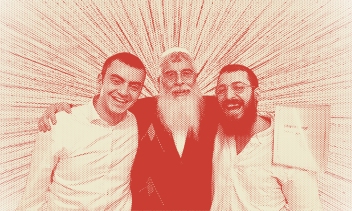It’s a classic scene: 9:30 p.m. on a Sunday, Max is finishing up some work at home when his wife, Lisa, walks in from dinner with her friends. She sits on Max’s office couch while he sends his last email. A moment later, he turns to her, but Lisa has already taken out her phone. Good Lord, Max thinks, she just came home and here she goes again—on her phone, ignoring me. Max glares, hoping Lisa notices, but she doesn’t: I don’t want to disturb him, she thinks. He’ll just let me know when he’s done with his work.
It only takes five minutes for Max to have his dissertation written about Lisa’s misappropriated priorities. Meanwhile, he hasn’t vocalized anything, and Lisa remains clueless. When Lisa finally looks up, she notes Max’s expression. Lisa knows this face. It’s the face she sees when Max is upset about something but won’t say it. And Lisa knows that this face typically turns into a period of Max withdrawing, checking out, and not really talking to her.
“What?” She challenges.
“Nothing,” Max mumbles. And so begins their typical pursue-and-evade cycle. Lisa chases Max wanting to know what he’s upset about. “Just tell me,” she pleads again and again. Max drifts further away, shuts down, and retreats into his own world.
Next comes Lisa’s tears of anxiety, and she continues to look at the ghost of her husband. Lisa has been down this path many times before, but she can’t seem to find her stability when he gets like this, so she keeps pursuing him and struggling to stay sane in the meantime. All the while, Max becomes more and more tangled in his ruminating thoughts, keeping him bottled up and distant.
Research shows that Max and Lisa’s way of dealing with this innocuous phone situation has very little to do with their marriage and a whole lot more to do with early childhood. In the first three years of their lives, they each developed a particular “attachment style” that influenced how they’d react to this exact situation 30 years later.
Attachment Styles: How to Understand Your Relationships
Attachment styles refer to the way we generally engage in relationships, regardless of the particular content of that particular relationship. This operates much like the way a poet has a style of poetry running throughout their many different poems, or an interior designer who creates many designs but carries a consistency in their overall taste. We each engage relationships with our children, spouses, parents, friends, and colleagues with a general orientation and form despite each relationship carrying distinct content and particularities.
Theorists break attachment styles into three (and a half) styles:
- Secure: the ideal attachment style, is a pattern of engaging relationships with a balance of vulnerable dependency on others, coupled together with a healthy dose of individuation and self-sustainability.
- Anxious: a pattern of over-enmeshment and compulsive dependency on others.
- Avoidant: isolationist tendencies and a reluctance to engage vulnerability and closeness. (The last “half” style is called, Disorganized Attachment Style and it is a combination, or a swinging back and forth, between anxious and avoidant styles).
These styles are formed in the first few years of interaction with primary caregivers. For example, a child who feels she can only get her mother’s attention with an extra dose of tantrum will become emotionally overbearing on others in an effort to secure their attention. Alternatively, a child who feels safer from his father’s anger by bottling up his emotions will engage in all future relationships by swallowing his feelings. (Of course, these styles live on a spectrum, so it is never quite all-or-nothing.)
Our couple above, Max and Lisa, are a typical example of a profound avoidant style (Max) and a mild to moderate anxious style (Lisa). Identifying our attachment style can help us significantly in our relationships with other people. But it may also help us in another, somewhat unexpected way: our relationship with God.
Do We Have Relationship Issues with God?
According to one Midrash, when Moshe heard God speak to him from the burning bush, he did not hear the voice of Morgan Freeman. Rather, he heard God’s voice as the voice of his father. This is fascinating considering that Moshe only lived in his father’s home for the first three months of his life. But apparently, Chazal see that as sufficient time for Moshe to internalize his father’s voice as his paradigm Father-figure. Although Moshe did not encounter the burning bush until many years later, his earliest childhood experiences defined that experience of God’s voice.
The way we engage (or don’t engage) God may be a function of the very same attachment style that runs throughout our human-to-human relationships. Interactions with primary caregivers at the earliest stages of our life can shape the way we relate to our Primary Caregiver.
I’ve seen this with multiple clients in my practice. One client grew up with emotionally neglectful parents who always seemed too preoccupied to pay much attention to him. “I never understand why I would daven,” he once said to me. “I’ve never experienced anyone actually caring to hear what I’m thinking or feeling.”
Another client grew up in a religiously intense home where Talmudic excellence was the family membership card, and the expectation was to always live with as many stringencies as possible. No matter how much effort he put into his religious life, he struggled to believe that he could ever please God.
A third client had punitively oriented parents who used verbal and physical punishment as a means of authoritative reinforcement. Naturally, God, to this individual, was a Being filled with judgment and punishment.
A few years ago, I decided to test out this concept on myself. I wrote about my experience in my recent book, Attached: Connecting to Our Creator: A Psychological Approach:
I had, for many years, struggled with the belief that everything is from God. But as my therapy work grew and I guided more and more clients into seeing the psychological underpinnings of their spiritual challenges, I decided to turn my therapeutic approach inwards.
So, late one night, sitting on the couch, I started wondering why I struggled to accept God’s hand in everything. I asked myself the same question I ask my clients. What is the first thing that comes up on a gut level? The first thing was this: If I believed that God caused everything in my life to happen to me, then I’d have to accept that He also caused the things that have really hurt me. And if I believed that, then I’d be incredibly angry with Him. So, I continued turning my therapy work inwards, and said, maybe that’s okay. Maybe I can be angry with Him. A few weeks later, I noticed that my belief had completely changed. I accepted that everything is from God. Accepting and expressing my anger with God gave me more belief in Him.
A few years after writing this, I now have further insight into this experience. I always thought my reluctance to express anger and emotion with God was rooted in religious teachings that made it seem sacrilegious to express such sentiments towards God. While this may have been a contributing factor, I think another part of my standstill was the avoidant attachment style that kept me from expressing such feelings with people in general. It’s no coincidence that as I’ve become more emotionally present in relationships with others, I’ve also become more emotionally present with God. (Though, of course, there are “miles to go before I sleep”).
The Secret Behind Attachment Styles
Perhaps the most important insight in understanding attachment styles is that both anxious and avoidant types are rooted in a deep desire for connection. The drive for connection is so powerful that when it is consistently unmet, our system becomes unconsciously forced to respond by developing an adaptive coping mechanism in the form of anxiety or avoidance. But underneath these coping mechanisms is a deep longing for embrace.
Psychology, and attachment theory in particular, studies how we fulfill this longing through human-to-human interactions. Jewish life embraces and guides this form of fulfillment but also offers us another powerful avenue to quench our thirsty souls in the loving, powerful arms of God.
So, here’s a meditation to help develop your secure attachment with God. Try this meditation daily for a week, and see what happens to your relationship with God.
Find Secure Attachment to God
Find a quiet, comfortable space to spend a few undisturbed minutes.
Take a moment to begin. Allow your body to adjust so that you find a comfortable sitting position.
As you take your time, all the time you want, allow yourself to notice your breathing. In and out.
Notice your body… your feet… your hands… your back… the muscles in your face… With your next exhale, allow your eyes to gently close.
And notice your breath again. Perhaps your breath might be slower now. Longer breaths. Inhale. Exhale.
When you’re ready, I want you to think of a relationship that felt nurturing, empowering, confidence-boosting, loving, accepting, supportive, guiding, or any other positively oriented relationship.
Notice what it’s like to think of that person, perhaps a moment you had with them… notice what it’s like in your body when you think of them or that experience with them. Try to picture the scene with as much detail as possible.
Now, think of a second relationship that also has a positive quality, perhaps a similar quality, or perhaps a different positive quality. Notice what it’s like in your body when you think of this relationship. What physical sensations do you notice? What emotions do you feel?
When you’re ready, you can try to think of one more relationship with a similar or different positive quality. And again, notice what it’s like when you think of this person.
Now, move back and forth between these different relationships in your mind, spending a brief moment on each and then switching to the next one. Do this for a minute or two, continually rotating around the different relationships, noticing your internal experience while conjuring up images of memories around these individuals.
You can either take a deep breath and stop here, or consider one more experiment. Imagine a Being who has all the positive qualities you just experienced in these different relationships. You can imagine this being as a Light, as the Hebrew letters yud, hey, vuv, hey, or simply as an ambiguous presence. However you choose to try this out, notice what it’s like inside when you imagine a Being who relates to you with all the nurturing, loving, accepting, supporting, guiding, and strengthening qualities that you experienced in the relationships you just meditated on.
Sit with this for a moment. Take as long as you’d like. Notice your body, your breath, and your emotions.
Whenever you feel ready, take a few deep breaths, wiggle your toes, tap your fingers, and slowly open your eyes.
Rabbi Yakov Danishefsky LCSW CSAT is the founder of Mind Body Therapy, a group practice in Chicago, specializing in treating trauma, marital issues, sexual addiction, and other life challenges. Yakov is a popular speaker on topics related to Judaism, psychology, and philosophy. His book, Attached: Connecting to Our Creator, A Jewish Psychological Approach is currently in its third printing. Yakov’s podcast, The Attached Life, can be found on most podcasting platforms.








